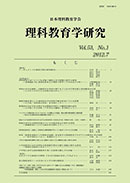Volume 45, Issue 1
Displaying 1-7 of 7 articles from this issue
- |<
- <
- 1
- >
- >|
Original Papers
-
2004Volume 45Issue 1 Pages 1-9
Published: May 17, 2004
Released on J-STAGE: June 30, 2022
Download PDF (1286K) -
2004Volume 45Issue 1 Pages 11-19
Published: May 17, 2004
Released on J-STAGE: June 30, 2022
Download PDF (1453K) -
2004Volume 45Issue 1 Pages 21-30
Published: May 17, 2004
Released on J-STAGE: June 30, 2022
Download PDF (1587K) -
2004Volume 45Issue 1 Pages 31-44
Published: May 17, 2004
Released on J-STAGE: June 30, 2022
Download PDF (2145K) -
2004Volume 45Issue 1 Pages 45-51
Published: May 17, 2004
Released on J-STAGE: June 30, 2022
Download PDF (967K) -
2004Volume 45Issue 1 Pages 53-61
Published: May 17, 2004
Released on J-STAGE: June 30, 2022
Download PDF (1000K)
Note
-
2004Volume 45Issue 1 Pages 63-69
Published: May 17, 2004
Released on J-STAGE: June 30, 2022
Download PDF (1434K)
- |<
- <
- 1
- >
- >|
